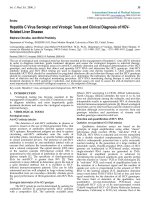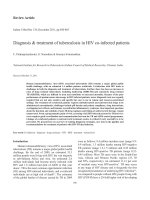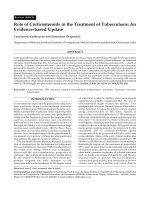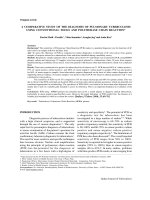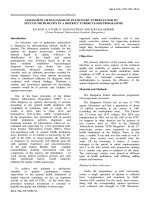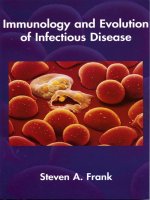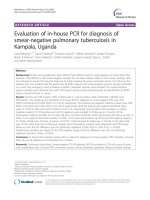Diagnosis of Tuberculosis Disease potx
Bạn đang xem bản rút gọn của tài liệu. Xem và tải ngay bản đầy đủ của tài liệu tại đây (1.01 MB, 34 trang )
Chapter 4
Diagnosis of Tuberculosis Disease
Table of Contents
Chapter Objectives 75
Introduction 77
Medical Evaluation. . . . . . . . . . . . . . . . . . . . . . . . . . . . . . . . . . . . . . . . . . . . . . . . . . . . . . . . . . 78
Chapter Summary 104
References 106
Chapter Objectives
After working through this chapter, you should be able to
• Describe the ve components of a TB medical evaluation;
• Identify the major components of TB diagnostic microbiology;
• List at least ve symptoms of pulmonary TB disease;
• Explain the purpose and signicance of acid-fast bacilli (AFB);
• Explain the purpose and signicance of the culture; and
• Explain the purpose and signicance of genotyping.
Chapter 4: Diagnosis of TB Disease
75
Chapter 4: Diagnosis of TB Disease
76
Introduction
Tuberculosis (TB) is not as common as it was many years ago in the United States; consequently,
clinicians do not always consider the possibility of TB disease when evaluating patients who have
symptoms. As a result, the diagnosis of TB disease may be delayed or even overlooked, and the
patient may remain ill and possibly infectious for a prolonged period.
Not all persons with TB disease have symptoms; however, most persons with TB disease have one or
more symptoms that lead them to seek medical care. All persons with symptoms of TB disease, or
either a positive tuberculin skin test (TST) or an interferon-gamma release assay (IGRA) indicative
of M. tuberculosis infection, should be medically evaluated to exclude TB disease.
Not all persons with TB disease have symptoms; however, most persons with
TB disease have one or more symptoms that lead them to seek medical care.
All persons with symptoms of TB disease, or either a positive
TST or IGRA indicative of M. tuberculosis infection, should
be medically evaluated to exclude TB disease.
Study Question
4.1 All persons with symptoms of TB disease, or a positive TST or IGRA result indicating
M. tuberculosis infection, should be medically evaluated to exclude TB disease.
(choose the one best answer)
A. Tr u e
B. False
Chapter 4: Diagnosis of TB Disease
77
Medical Evaluation
A complete medical evaluation for TB disease includes the following ve components:
1. Medical history
2. Physical examination
3. Test for M. tuberculosis infection
4. Chest radiograph
5. Bacteriologic examination of clinical specimens.
1. Medical History
When conducting a medical history, the clinician should ask if any symptoms of TB disease are
present; if so, for how long, and if there has been known exposure to a person with infectious
TB disease. Equally important is obtaining information on whether or not the person has been
diagnosed in the past with latent tuberculosis infection (LTBI) or TB disease. Clinicians may also
contact the local health department for information on whether a patient has a past history of TB
infection or disease. If the previous treatment regimen for TB disease was inadequate or if the patient
did not adhere to therapy, TB disease may recur and possibly be drug-resistant. It is important to
consider demographic factors (e.g., country of origin, age, ethnicity, occupation, or racial group)
that may increase the patient’s risk for being exposed to TB infection (see Chapter 2, Transmission
and Pathogenesis of Tuberculosis). Clinicians should determine if the patient has underlying medical
conditions, especially human immunodeciency virus (HIV) infection or diabetes, that increase the
risk for progression to TB disease in those latently infected with M. tuberculosis.
Clinicians should determine if the patient has underlying medical
conditions, especially HIV infection and diabetes, that increase the risk for
progression to TB disease in those latently infected with M. tuberculosis.
As discussed in Chapter 2, Transmission and Pathogenesis of Tuberculosis, TB disease most
commonly aects the lungs and is referred to as pulmonary TB disease. Pulmonary TB disease
usually causes one or more of the symptoms indicated in Table 4.1.
TB disease most commonly aects the lungs and
is referred to as pulmonary TB disease.
Chapter 4: Diagnosis of TB Disease
78
Extrapulmonary TB disease may cause symptoms related to the part of the body that is aected
(Table 4.1). For example, TB of the spine may cause back pain; TB of the kidney may cause blood
in the urine; TB meningitis may cause headache or confusion. Extrapulmonary TB disease should
be considered in the dierential diagnosis of ill persons who have systemic symptoms and who are at
high risk for TB disease.
Both pulmonary and extrapulmonary TB disease symptoms can be caused by other diseases;
however, they should prompt the clinician to consider TB disease.
Both pulmonary and extrapulmonary TB disease symptoms
can be caused by other diseases; however, they should
prompt the clinician to consider TB disease.
Table 4.1
Symptoms of Pulmonary and Extrapulmonary TB Disease
Symptoms of
Pulmonary TB Disease
(TB disease usually causes
one or more of the symptoms)
Symptoms of
Possible Extrapulmonary TB Disease
(Depends on the part of the body
that is aected by the disease)
• Cough (especially if lasting for 3 weeks or • TB of the kidney may cause blood in the urine
longer) with or without sputum production
• TB meningitis may cause headache or
• Coughing up blood (hemoptysis) confusion
• Chest pain • TB of the spine may cause back pain
• Loss of appetite • TB of the larynx can cause hoarseness
• Unexplained weight loss • Loss of appetite
• Night sweats • Unexplained weight loss
• Fever • Night sweats
• Fatigue • Fever
• Fatigue
Chapter 4: Diagnosis of TB Disease
79
____
____
Study Questions
Match the patient symptoms with the type of TB.
(Choose the one best answer and write the letter for the correct answer on the line next to the
question number.)
Patient Symptoms Type of TB
4.2
4.3
Regina has back pain and blood in her
urine, unexplained weight loss, fever,
fatigue, loss of appetite.
Maria has a cough, loss of appetite, and
unexplained weight loss. She has also been
coughing up blood.
A. Pulmonary TB
B. Extrapulmonary TB
2. Physical Examination
A physical examination is an essential part of the evaluation of any patient. It cannot be used to
conrm or rule out TB disease, but it can provide valuable information about the patient’s overall
condition, inform the method of diagnosis, and reveal other factors that may aect TB disease
treatment, if diagnosed.
A physical examination is an essential part of the evaluation of
any patient. It cannot be used to conrm or rule out TB disease,
but it can provide valuable information about the patient’s overall
condition, inform the method of diagnosis, and reveal other
factors that may aect TB disease treatment, if diagnosed.
Study Question
4.4 A physical examination can be used to confirm and rule out TB disease.
(circle the one best answer)
A. Tr u e
B. False
Chapter 4: Diagnosis of TB Disease
80
3. Test for M. tuberculosis Infection
Selection of the most suitable tests for detection of M. tuberculosis infection should be based on
the reasons and the context for testing, test availability, and overall cost eectiveness of testing.
Currently, there are two methods available for the detection of M. tuberculosis infection in the United
States. e tests are:
• Mantoux tuberculin skin test (TST) (Figure 4.1); and
• Interferon-gamma release assays (IGRAs)*
» QuantiFERON-TB Gold In-Tube test (QFT-GIT) (Figure 4.2);
» T-SPOT®.TB test (Figure 4.3).
*See Chapter 3, Testing for Tuberculosis Infection and Control
Figure 4.1
Mantoux Tuberculin
Skin Test
Figure 4.2
QuantiFERON-TB Gold
In-Tube Test (QFT-GIT)
Figure 4.3
T-SPOT®.TB Test
ese tests help clinicians dierentiate people infected with M. tuberculosis from those uninfected.
However, a negative reaction to any of the tests does not exclude the diagnosis of TB disease or LTBI
(see Chapter 3, Testing for Tuberculosis Infection and Disease).
TST and QFT tests help clinicians dierentiate people infected with
M. tuberculosis from those uninfected. However, a negative reaction to
any of the tests does NOT exclude the diagnosis of TB disease or LTBI.
Study Question
4.5 A negative reaction for a TST or IGRA test excludes a person from having TB disease.
(choose the one best answer)
A. Tr u e
B. False
Chapter 4: Diagnosis of TB Disease
81
4. Chest Radiograph
With pulmonary TB being the most common form of disease, the chest radiograph is useful for
diagnosis of TB disease. Chest abnormalities can suggest pulmonary TB disease (Figure 4.4). A
posterior-anterior radiograph of the chest is the standard view used for the detection of TB-related
chest abnormalities. In some cases, especially in children, a lateral view may be helpful.
Figure 4.4
Chest Radiograph with Lower Lobe Cavity
In some instances, a computerized tomography (CT) scan may provide additional information. A
CT scan provides more detailed images of parts of the body that cannot easily be seen on a standard
chest radiograph; however, CT scans can be substantially more expensive.
In pulmonary TB disease, radiographic abnormalities are often seen in the apical and posterior
segments of the upper lobe or in the superior segments of the lower lobe. However, lesions may
appear anywhere in the lungs and may dier in size, shape, density, and cavitation, especially in HIV-
infected and other immunosuppressed persons. Radiographic abnormalities in children tend to be
minimal with a greater likelihood of lymphadenopathy, more easily diagnosed on the lateral lm.
Mixed nodular and brotic lesions may contain slowly multiplying tubercle bacilli and have the
potential for progression to TB disease. Persons who have lesions consistent with ndings of “old”
TB disease on a chest radiograph and have a positive TST reaction or positive IGRA result should
be considered high-priority candidates for treatment of LTBI (see Chapter 5, Treatment for Latent
Tuberculosis Infection), but only after TB disease is excluded by obtaining three specimens for
AFB smear and culture because “old” TB cannot be dierentiated from active TB disease based on
radiographic appearance alone. Conversely, fully calcied, discrete, nodular lesions without brosis
likely represent granulomas and pose a lower risk for future progression to TB disease.
Chapter 4: Diagnosis of TB Disease
82
In HIV-infected persons, pulmonary TB disease may present with atypical ndings or with no
lesions seen on the chest radiograph. e radiographic appearance of pulmonary TB disease in
persons infected with HIV might be typical; however, cavitary disease is less common among such
patients. More common chest radiograph ndings for HIV-infected persons include inltrates in
any lung zone, mediastinal or hilar adenopathy, or, occasionally, a normal chest radiograph. Typical
cavitary lesions are usually observed in patients with higher CD4 counts, and more atypical patterns
are observed in patients with lower CD4 counts because cavitation is thought to occur as a result of
the immune response to TB organisms. In HIV-infected persons, almost any abnormality on a chest
radiograph may be indicative of TB disease. In patients with symptoms and signs of TB disease, a
negative chest radiograph result does not exclude TB disease.
Abnormalities seen on chest radiographs may be suggestive of, but are never diagnostic of, TB
disease. Chest radiographs may be used to exclude pulmonary TB disease in an HIV-negative person
who has a positive TST reaction or IGRA and who has no symptoms or signs of TB disease.
Abnormalities seen on chest radiographs may be suggestive of, but are
never diagnostic of, TB disease. Chest radiographs may be used to exclude
pulmonary TB disease in a person with a normal immune system who has a
positive TST reaction or IGRA and who has no symptoms or signs of TB disease.
Study Question
4.6 Chest radiographs may be used to exclude pulmonary TB disease in an HIV-negative
person who has a positive TST reaction or IGRA and who has no symptoms or signs of
TB disease. (choose the one best answer)
A. Tr u e
B. False
5. Bacteriologic Examination of Clinical Specimens
Examinations of clinical specimens (e.g., sputum, urine, or cerebrospinal uid) are of critical
diagnostic importance. e specimens should be examined and cultured in a laboratory that
specializes in testing for M. tuberculosis. e bacteriologic examination has ve parts:
• Specimen collection, processing, and review
• AFB smear classication and results
• Direct detection of M. tuberculosis in clinical specimen using nucleic acid amplication (NAA)
• Specimen culturing and identication
• Drug-susceptibility testing
Chapter 4: Diagnosis of TB Disease
83
Specimen Collection, Processing, and Review
For diagnostic purposes, all persons suspected of having TB disease at any site should have sputum
specimens collected for an AFB smear and culture, even those without respiratory symptoms. At least
three consecutive sputum specimens are needed, each collected in 8- to 24-hour intervals, with at
least one being an early morning specimen. If possible, specimens should be obtained in an airborne
infection isolation (AII) room or other isolated, well-ventilated area (e.g., outdoors) (Figure 4.5).
For diagnostic purposes, all persons suspected of having TB disease
at any site should have sputum collected for TB culture. At least three
consecutive sputum specimens are needed, each collected in 8- to 24-
hour intervals, with at least one being an early morning specimen.
Figure 4.5
TB Patient Coughing Up Sputum
A TB patient has coughed up sputum and is spitting it into a sterile
container. e patient is sitting in a special sputum collection booth
that, if properly ventilated, prevents the spread of tubercle bacilli.
For diagnostic purposes, all persons suspected of having TB disease
should have sputum collected for AFB smear and culture.
During specimen collection, patients produce an aerosol that may be hazardous to health-care
workers or other patients in close proximity. For this reason, precautionary measures for infection
control must be followed during sputum induction, bronchoscopy, and other common diagnostic
procedures (see Chapter 7, TB Infection Control).
Chapter 4: Diagnosis of TB Disease
84
During specimen collection, patients produce an aerosol that may be
hazardous to health-care workers or other patients in close proximity.
Specimen Collection Methods for Pulmonary TB Disease
ere are four specimen collection methods for pulmonary TB disease (Table 4.2):
• Coughing
• Induced sputum
• Bronchoscopy
• Gastric aspiration
Coughing – Coughing is the most commonly used method of sputum collection. Coughing
should be supervised to ensure that sputum is collected correctly. A health-care worker wearing the
recommended personal protective equipment should coach and directly supervise the patient when
sputum is collected (Figure 4.6). Patients should be informed that sputum is the material brought
up from the lungs, and that mucus from the nose or throat and saliva are not good specimens.
Unsupervised patients are less likely to provide an adequate specimen, especially the rst time.
Patients should be informed that sputum is the material
brought up from the lungs, and that mucus from the nose
or throat and saliva are not good specimens.
Figure 4.6
Patient Coughing Up Sputum
Sputum Induction – For patients unable to cough up sputum, deep sputum-producing coughing
may be induced by inhalation of an aerosol of warm, sterile, hypertonic saline (3%–5%). Because
induced sputum is very watery and resembles saliva, it should be labeled “induced” to ensure that the
laboratory sta workers do not discard it.
Chapter 4: Diagnosis of TB Disease
85
Bronchoscopy – A bronchoscopy is a medical procedure that allows visualization of the inside of
a person’s airways. e airways are called the bronchial tubes or bronchi. Bronchoscopy might be
needed for specimen collection, especially if previous results have been nondiagnostic and doubt
exists as to the diagnosis. At other times, bronchoscopy is considered because TB is among several
other diagnoses being considered. If possible, examine three spontaneous or induced sputum to
exclude a diagnosis of TB disease before bronchoscopy. If possible, avoid bronchoscopy on patients
with suspected or conrmed TB disease or postpone the procedure until the patient is determined
to be noninfectious, by conrmation of the three negative AFB sputum smear results (Figure
4.7). Bronchial washings, brushings, and biopsy specimens may be obtained, depending on the
bronchoscopy ndings. Sputum collected after a bronchoscopy may also be useful for a diagnosis.
A bronchoscopy should never be substituted for sputum collection, but rather used as an additional
diagnostic procedure.
Figure 4.7
Performing a Bronchoscopy
Whenever feasible, bronchoscopy should be performed in a room that meets the ventilation
requirements for an airborne infection isolation (AII) room. Health-care workers should wear N95
respirators while present during a bronchoscopy procedure on a patient with suspected or conrmed
infectious TB disease (see Chapter 7, TB Infection Control).
Chapter 4: Diagnosis of TB Disease
86
Gastric Aspiration – Gastric aspiration is a procedure sometimes used to obtain a specimen for
culture when a patient cannot cough up adequate sputum. A tube is inserted through the mouth
or nose and into the stomach to recover sputum that was coughed into the throat and then
swallowed. is procedure is particularly useful for diagnosis in children, who are often unable
to cough up sputum (Figure 4.8). Gastric aspiration often requires hospitalization and should be
done in the morning before the patient gets out of bed or eats, as it is the optimal time to collect
swallowed respiratory secretions from the stomach. Specimens obtained by gastric aspiration should
be transported to the lab immediately for neutralization or neutralized immediately at the site of
collection.
Figure 4.8
Performing a Gastric Aspiration
Chapter 4: Diagnosis of TB Disease
87
Table 4.2
Methods of Obtaining a Sputum Specimen
Method Description Advantage Disadvantage
Spontaneous Patient coughs up • Inexpensive • Patient may not be able to
sputum sample sputum into a sterile
container
• Easy to do
cough up sputum without
assistance or may spit up
saliva instead of sputum
• Health-care worker has to
coach and supervise the
patient when collecting
sputum
Sputum induction Patient inhales a
saline mist which
can cause a deep
cough
• Easy to do
• Use to obtain
sputum when
coughing sputum
is not productive
• Specimens may be watery
and may be confused with
saliva (should be labeled
“induced specimen”)
• Requires special
equipment
• May cause bronchospasm
Bronchoscopy Bronchoscope is
passed through
the mouth or nose
directly into the
diseased portion
of the lung, and
sputum or lung
tissue is removed
Use to obtain
sputum when
coughing or
inducing sputum is
not productive or
other diagnoses are
being considered
• Most expensive and
invasive procedure
• Requires special
equipment
• Must be done by a
specialist in a hospital or
clinic
• Requires anesthesia
Gastric washing Tube is inserted
through the
patient’s mouth or
nose and passed
into the stomach
to get a sample of
gastric secretions
Use to obtain
samples in children,
who do not
produce sputum
when they cough
• Must be done as soon as
patient wakes up in the
morning; patient may be
required to stay in hospital
• Can be uncomfortable for
the patient
that contain sputum
that has been
coughed into the
throat and then
swallowed
Chapter 4: Diagnosis of TB Disease
88
Specimen Collection Methods for Extrapulmonary TB
TB disease can occur in almost any anatomical site; thus, a variety of clinical specimens other than
sputum (e.g., urine, cerebrospinal uid, pleural uid, pus, or biopsy specimens) may be submitted
for examination when extrapulmonary TB disease is suspected (Figures 4.9 and 4.10). Procedures
for the expeditious and recommended handling of the specimen must be in place or assured before
the specialist performs an invasive procedure to obtain the specimen. Especially important is rapid
transportation to the laboratory according to the laboratory’s instructions. It is important to note
that the portion of the specimen placed in formalin for histologic examination cannot be used for
culture.
TB disease can occur in almost any anatomical site; thus, a variety
of clinical specimens other than sputum (e.g., urine, cerebrospinal
uid, pleural uid, pus, or biopsy specimens) may be submitted for
examination when extrapulmonary TB disease is suspected.
Figure 4.9
Clinical Specimen Used for
Examination When Extrapulmonary
TB Disease Is Suspected
Figure 4.10
Collection Bottles Used for Collecting
Specimens When Extrapulmonary
TB Disease Is Suspected
AFB Smear Classication and Results
Detection of acid-fast bacilli in stained and acid-washed smears examined microscopically may
provide the initial bacteriologic evidence of the presence of mycobacteria in a clinical specimen
(Figure 4.11). Smear microscopy is the quickest and easiest procedure that can be performed.
Detection of acid-fast bacilli in stained and acid-washed smears
examined microscopically may provide the rst bacteriologic
evidence of the presence of mycobacteria in a clinical specimen.
Chapter 4: Diagnosis of TB Disease
89
Figure 4.11
Acid-Fast Bacilli Stained in Smear
Tubercle bacilli are shown in red
ere are two procedures commonly used for acid-fast staining:
• Carbolfuchsin methods which include the Ziehl-Neelsen and Kinyoun methods
(direct microscopy)
• Fluorochrome procedure using auramine-O or auramine-rhodamine dyes
(uorescent microscopy).
Studies have shown that there must be 5,000 to 10,000 bacilli per milliliter of specimen to allow the
detection of bacteria in stained smears. In contrast, 10 to 100 bacilli are needed for a positive culture.
Smear examination is a quick procedure; results should be available within 24 hours of specimen
collection when specimens are delivered to the laboratory promptly. However, smear examination
permits only the presumptive diagnosis of TB disease because the acid-fast bacilli in a smear may be
acid-fast organisms other than M. tuberculosis. Also, many TB patients have negative AFB smears
with a subsequent positive culture. Negative smears do not exclude TB disease (Table 4.3).
Many TB patients have negative AFB smears with a subsequent
positive culture. Negative smears do not exclude TB disease.
When acid-fast bacilli are seen in a smear, they are counted. ere is a system for reporting the
number of acid-fast bacilli that are seen at a certain magnication. According to the number of
acid-fast bacilli seen, the smears are classied as 4+, 3+, 2+, or 1+. e greater the number, the more
infectious the patient (Table 4.3).
Chapter 4: Diagnosis of TB Disease
90
Table 4.3
Smear Classication Results
Classication of Smear Smear Result Infectiousness of Patient
4+
(10 times as many acid-fast
bacilli as 3+ smears)
Strongly positive Probably very infectious
3+
(10 times as many acid-fast
bacilli as 2+ smears)
Strongly positive Probably very infectious
2+
(10 times as many acid-fast
bacilli as 1+ smears)
Moderately positive Probably infectious
1+ Moderately positive Probably infectious
Actual number of
acid-fast bacilli seen
(no plus sign)
Weakly positive Probably infectious
No acid-fast bacilli seen Negative Probably not infectious*
* The criteria for determining whether a patient may be considered noninfectious are discussed in Chapter 7 on
TB Infection Control
Direct Detection of M. tuberculosis in Clinical Specimen Using Nucleic Acid
Amplication (NAA)
NAA tests are used to amplify DNA and RNA segments to rapidly identify the microorganisms in a
specimen. NAA testing can reliably detect M. tuberculosis bacteria in specimens in hours as compared
to 1 week or more for culture (Figure 4.12). Possible benets of using NAA tests include
• Earlier laboratory conrmation of TB disease;
• Earlier treatment initiation;
• Improved patient outcomes;
• Interruption of transmission by early diagnosis, respiratory isolation and appropriate treatment;
• Earlier, more ecient use of respiratory isolation;
• Earlier initiation of contact investigation; and
• More eective public health interventions.
Chapter 4: Diagnosis of TB Disease
91
NAA tests are used to amplify DNA and RNA segments to
rapidly identify the microorganisms in a specimen.
CDC recommends that NAA testing be performed on at least one respiratory specimen from each
patient with signs and symptoms of pulmonary TB for whom a diagnosis of TB is being considered
but has not yet been established, and for whom the test result would alter case management or TB
control activities, such as contact investigations.
Figure 4.12
Nucleic Acid Amplication (NAA) Test
Clinicians should interpret all laboratory results in the context of the clinical situation. A single
negative NAA test result should not be used as a denitive result to exclude TB disease, especially
when the clinical suspicion of TB disease is moderate to high. Rather, the negative NAA test result
should be used as additional information in making clinical decisions, to expedite testing for an
alternative diagnosis, or to prevent unnecessary TB disease treatment.
Culture remains the gold standard for laboratory conrmation of TB disease, and growing bacteria
are required to perform drug-susceptibility testing and genotyping. In accordance with current
recommendations, sucient numbers and portions of specimens should always be reserved for
culture. Nonetheless, NAA testing should become standard practice for patients suspected of having
TB, and all clinicians and public health TB programs should have access to NAA testing for TB to
shorten the time to diagnosis.
Culture remains the gold standard for laboratory conrmation
of TB disease, and growing bacteria are required to perform
drug-susceptibility testing and genotyping.
Chapter 4: Diagnosis of TB Disease
92
Specimen Culture and Identication
Positive cultures for M. tuberculosis conrm the diagnosis of TB disease; however, in the absence
of a positive culture, TB disease may also be diagnosed on the basis of clinical signs and symptoms
alone. Culture examinations should be done on all diagnostic specimens, regardless of AFB smear or
NAA results. e commercially available broth culture systems (e.g., BACTEC, MGIT, VersaTREK,
MBBACT) allow detection of most mycobacterial growth in 4 to 14 days compared to 3 to 6 weeks
for solid media (Figure 4.13). Laboratories performing TB cultures should routinely use a broth-
based system (Table 4.4).
Positive cultures for M. tuberculosis conrm the diagnosis of TB disease;
however, in the absence of a positive culture, TB disease may also be
diagnosed on the basis of clinical signs and symptoms alone.
Culture examinations should be done on all diagnostic
specimens, regardless of AFB smear or NAA results.
Figure 4.13
Colonies of M. tuberculosis Grown in Culture
Chapter 4: Diagnosis of TB Disease
93
Table 4.4
Dierences Between Sputum Smears and Cultures
Feature Smears Cultures
Equipment needed • Microscope
• Glass slides
• Special dyes
• Incubators
• Safety cabinet
• Culture plates or tubes
• Culture media, biochemicals for tests
Time needed to
make report
• 1 day • 4 days to 12 weeks (depending on
method used and how quickly the
organism grows)
Basis of procedure
• Looking for acid-fast bacilli
on slide under microscope
• Growth and identication of tubercle
bacilli or other mycobacteria on culture
media in incubator
Signicance of a
negative report
• Patient is probably not
infectious
• Does not rule out TB disease
(culture may be positive)
• No live tubercle bacilli found in
specimen
• Does not rule out TB disease (live
tubercle bacilli may be in other
specimens and/or body sites)
Signicance of a
positive report
• Patient is more likely to be
infectious (if acid-fast bacilli
are tubercle bacilli)
• Acid-fast bacilli could
be nontuberculous
mycobacteria
• Conrms diagnosis of TB disease
Follow-up Bacteriologic Examination
Follow-up bacteriologic examinations are important for assessing the patient’s infectiousness
and response to therapy. Specimens should be obtained at monthly intervals until two consecutive
specimens sent for culture are reported as negative. Culture conversion is the most important
objective measure of response to treatment. Conversion is documented by the rst negative
culture in a series of previously positive cultures. In addition, all subsequent culture results must
remain negative.
Specimens should be obtained at monthly intervals until
two consecutive specimens sent for culture are reported as negative.
Chapter 4: Diagnosis of TB Disease
94
Reporting Results
Laboratories should report initial positive smears, positive M. tuberculosis cultures, and positive
NAA results within 24 hours by telephone or fax to the primary health-care provider and health
department. Out-of-state laboratories who receive referral specimens must contact the health-care
provider and health department in the patient’s state of origin. Follow-up results may be reported
by mail. It is the responsibility of the primary health-care provider to report all suspected or
conrmed cases of TB disease promptly to the state or local health department unless state laws
indicate otherwise. Prompt reporting to health authorities ensures that the person with TB disease
can be adequately treated, interrupting the potential for ongoing transmission. It also ensures that
contact investigations can be initiated quickly to nd contacts of the patient who may have LTBI
or TB disease.
Laboratories should report initial positive smears, positive M. tuberculosis
cultures, and positive NAA results within 24 hours by telephone or
fax to the primary health-care provider and health department.
Drug-Susceptibility Testing
For all patients, the initial M. tuberculosis isolate should be tested for resistance to the rst-line
anti-TB drugs: isoniazid, rifampin, ethambutol, and pyrazinamide (Figure 4.14). e results of
drug-susceptibility tests should direct clinicians to choose the appropriate drugs for treating each
patient. Patients with TB disease who are treated with drugs to which their strain of TB is resistant
may not be successfully cured. In fact, their strain of TB may become resistant to additional drugs.
For all patients, the initial M. tuberculosis isolate should
be tested for resistance to the rst-line anti-TB drugs:
isoniazid, rifampin, ethambutol, and pyrazinamide.
Chapter 4: Diagnosis of TB Disease
95
Figure 4.14
Drug-Susceptibility Testing
Rapid, broth-based systems should be used to identify drug resistance as early as possible in order to
ensure appropriate treatment. Susceptibility results from laboratories should be promptly forwarded
to the physician and health department. Drug-susceptibility tests should be repeated for patients
who do not respond as expected or who have positive culture results despite 3 months of adequate
treatment.
Second-line drug susceptibility testing should be done only in reference laboratories and generally be
limited to specimens from patients who have the following characteristics:
• Prior TB disease treatment;
• Contact with a patient with known anti-TB drug resistance;
• Demonstrated resistance to rst-line anti-TB drugs; or
• Positive cultures after more than 3 months of treatment.
A patient is diagnosed with multidrug-resistant TB (MDR TB) disease if the organisms are
resistant to at least isoniazid and rifampin, the two most potent rst-line anti-TB drugs. A patient
is diagnosed with extensively drug-resistant TB (XDR TB) disease if the TB isolate is resistant to
isoniazid and rifampin, any uoroquinolone, and at least one of three injectable second-line drugs
(i.e., amikacin, kanamycin, or capreomycin).
A patient is diagnosed with multidrug-resistant TB (MDR TB)
disease if the organisms are resistant to at least isoniazid and
rifampin, the two most potent rst-line anti-TB drugs.
Chapter 4: Diagnosis of TB Disease
96
A patient is diagnosed with extensively drug-resistant TB (XDR TB)
disease if the isolate is resistant to isoniazid and rifampin,
any uoroquinolone, and at least one of three injectable
second-line drugs (i.e., amikacin, kanamycin, or capreomycin).
Molecular Detection of Drug Resistance
e drug resistance of clinical isolates as determined by conventional methods (e.g, broth-based
and agar proportion) is due to the presence of mutations in specic M. tuberculosis genes. ese
mutations often are single base pair changes in the DNA sequence of the bacteria. ere are a variety
of commercial assays and laboratory developed tests that can detect mutations associated with drug
resistance. e assays are done on patient specimens or isolates from patient specimens.
• Line-probe assays use polymerase chain reaction (PCR) to amplify the region of a gene known
to be associated with resistance. e amplied product is labeled and specically joins to
probes on a nitrocellulose strip. Mutations are detected by the lack of binding to probes with
the normal sequence or by binding to probes specic for commonly occurring mutations.
• PCR amplication of genes known to be associated with drug resistance can be followed by
DNA sequencing that can detect mutations.
• Real-time PCR with uorescing probes that specically join to the target can do so in one step,
a technique sometimes called “molecular beacons.”
All of these assays allow rapid detection of drug resistance through the identication of genetic
mutations associated with resistance and provide preliminary guidance on eective therapy.
Molecular detection of drug resistance should be considered for patients with the following
characteristics:
• High risk of rifampin resistance, including MDR TB (e.g., previously treated TB, contact with
someone with MDR TB, or being foreign born from a high-risk country);
• First-line drug susceptibility results are available and show resistance to rifampin;
• Infectiousness poses a risk to vulnerable contacts (e.g., daycare workers, nurses, and infants); and
• Contraindications to essential rst-line medications (e.g., rifampin allergy).
A limitation of molecular testing for drug resistance is that the clinical relevance of some mutations
remains unknown. Further, not all biological mechanisms of resistance are known. As a result,
if no mutations are detected by the molecular assay, resistance cannot be ruled out. erefore,
it is essential that conventional growth-based drug-susceptibility tests are done and used in
conjunction with molecular results.
It is essential that conventional growth-based drug-susceptibility
tests are done and used in conjunction with molecular results.
Chapter 4: Diagnosis of TB Disease
97
____
____
____
____
____
____
____
____
____
____
____
Study Questions
Indicate which of the following activities is a component of a complete medical evaluation for
TB. (Choose the one best answer and write the letter for the correct answer on the line next to the
question number.)
Activity Yes or No
4.7 Medical history
4.8 Physical examination
4.9 Test for M. tuberculosis infection
4.10 Chest radiograph
4.11 Bone density testing
4.12 Bacteriological examination of
clinical specimens
A. Yes, is a component
of a complete medical
evaluation for TB
B. No, is not a component
of a complete medical
evaluation for TB
Match the specimen collection method with how to use it.
(Choose the one best answer and write the letter for the correct answer on the line next to the
question number.)
Use of Specimen Collection Method Method
4.13 Use only if there is a suspicion of TB disease
and there are three negative sputum smears
or induced sputum AFB results.
4.14 Best way to obtain specimens from children
who cannot produce sputum.
4.15 Use for extrapulmonary TB disease.
4.16 Use for patients unable to cough up sputum
to encourage deep coughing.
4.17 Most common method for collecting
sputum.
A. Coughing
B. Sputum induction
C. Bronchoscopy
D. Gastric aspiration
E. Biopsy
Chapter 4: Diagnosis of TB Disease
98
4.18 What do laboratory personnel look for in a sputum smear?
(choose the one best answer)
A. White-blood cells
B. Fast-moving bacilli
C. Drug-resistant bacilli
D. Acid-fast bacilli
Case Study – Chin
Chin has symptoms of TB disease and a cavity on his chest radiograph, but all of his
sputum smears are negative for acid-fast bacilli.
4.19 Does this rule out the diagnosis of pulmonary TB disease for Chin?
(circle the one best answer)
A. Yes, because his sputum smears are negative for acid-fast bacilli. Even though he has
symptoms of TB disease and a cavity on his chest radiograph, his sputum smears have to
be positive for acid-fast bacilli to indicate a diagnosis of pulmonary TB disease.
B. No, because he has symptoms of TB disease and his abnormal chest x-ray suggest that
he does have pulmonary TB disease. Also, M. tuberculosis may grow in the cultures even
though there are no acid-fast bacilli on the smear.
Chapter 4: Diagnosis of TB Disease
99
